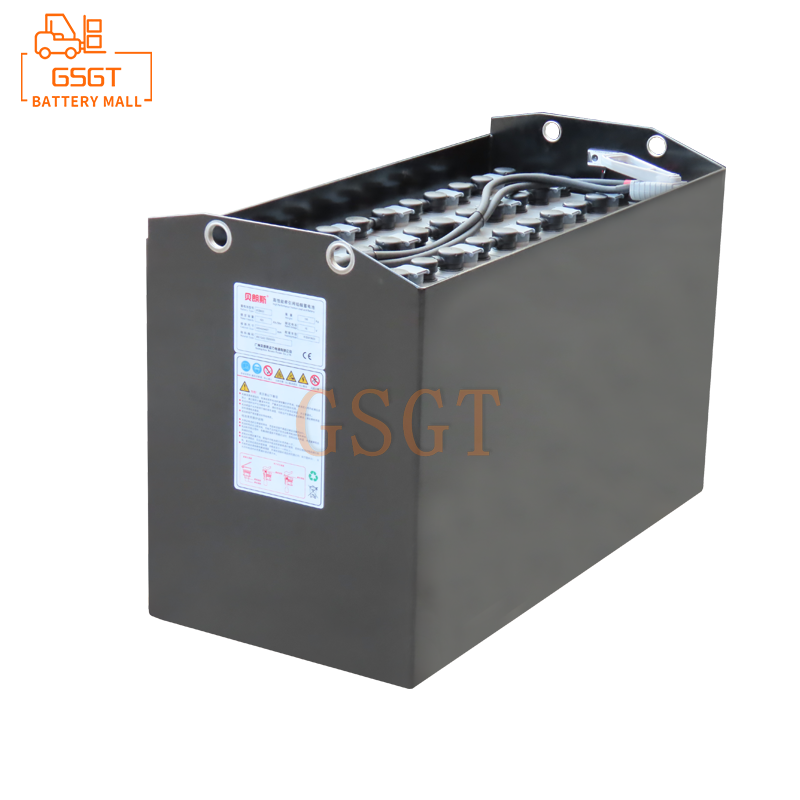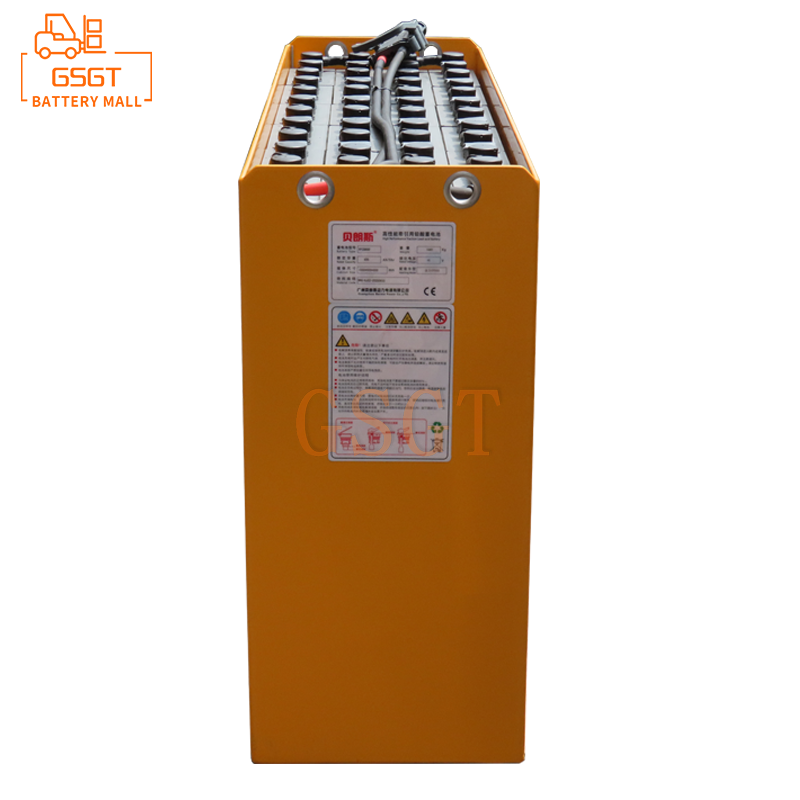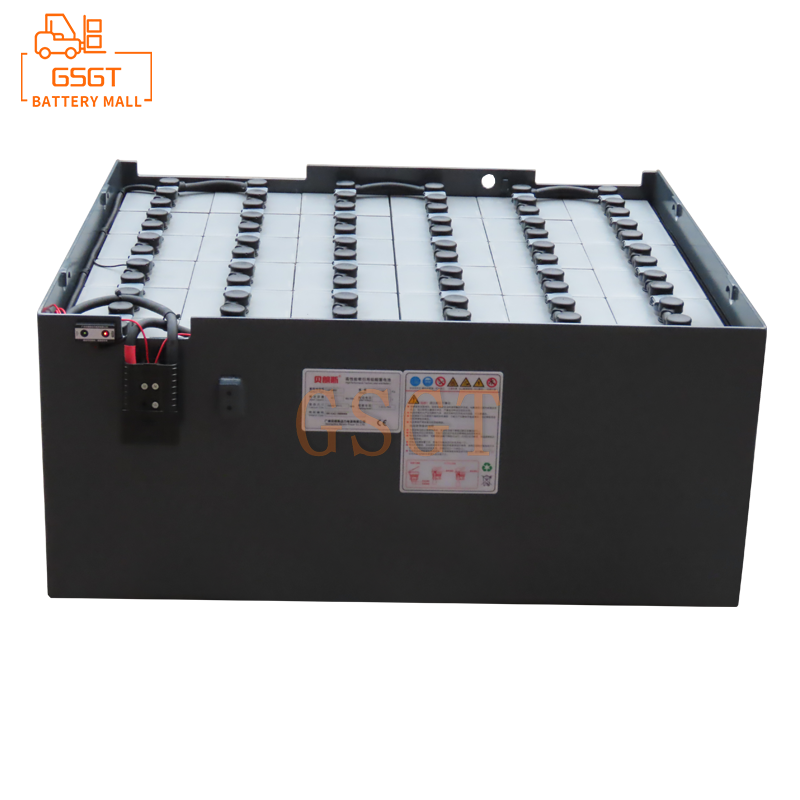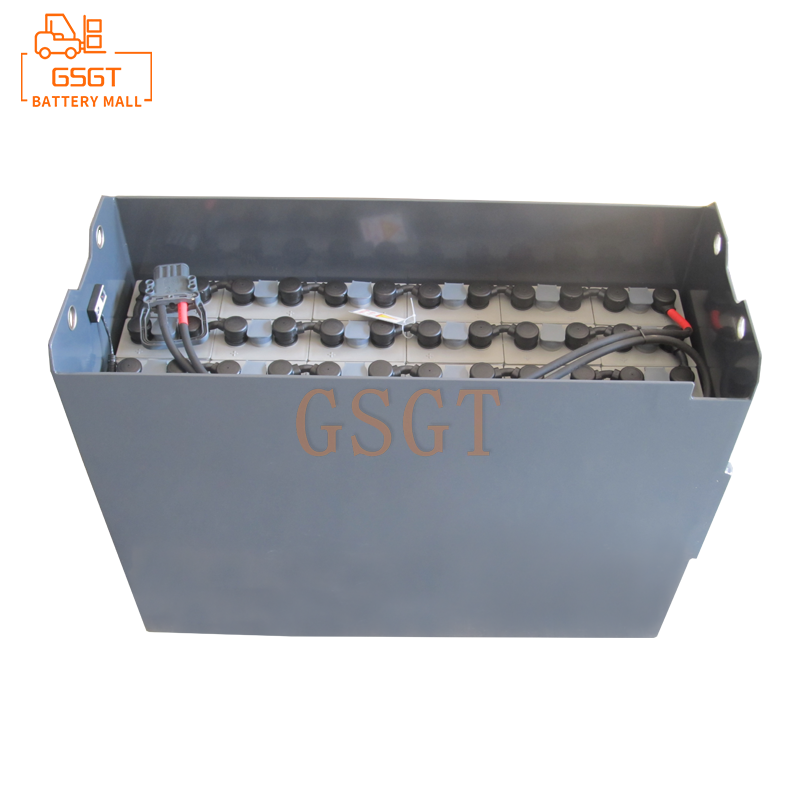Time:2025-04-12 09:40:45
Browse:448
Introduction
In logistics warehousing, industrial production and other fields, forklift as a key material handling equipment, its power source performance is very important. Lead-acid battery with its mature technology, relatively low cost, high rate discharge performance and other advantages, has long occupied an important position in the field of forklift power. With the development of the industry, higher requirements have been put forward for the work efficiency, service life and maintenance convenience of forklifts, which also promotes the continuous technological innovation of high-quality forklift traction lead-acid batteries. In-depth exploration of its core technology has far-reaching significance for improving the overall performance of forklifts, reducing operating costs and promoting the sustainable development of the industry.
Key structural components
1. ** Plate ** : plate is the core component of the lead-acid battery, which is divided into positive plate and negative plate. The quality and structure of the plate directly affect the performance of the battery. High quality plates are made of special lead alloy materials, such as lead calcium alloy, lead antimony alloy, etc. The lead-calcium alloy plate has good corrosion resistance and can effectively extend the battery life. The lead-antimony alloy plate performs well at high rate discharge, and can meet the demand of instantaneous large current discharge of forklift trucks. The manufacturing process of the plate is also very critical, such as the use of mesh plate manufacturing technology, which can make the active substance distribution of the plate more uniform, improve the specific surface area of the plate, thereby improving the charge and discharge performance of the battery.
2. ** Separator ** : The separator is located between the positive and negative plates, and its main function is to prevent short circuit of the positive and negative plates, while allowing ions in the electrolyte to pass freely. For forklift to pull lead-acid batteries, the use of microporous rubber partition or polypropylene partition. The microporous rubber separator has high mechanical strength and good chemical stability, and can withstand various stresses in the process of battery charging and discharging. The polypropylene separator has the advantages of small aperture, low resistance and good air permeability, which helps to improve the performance and life of the battery. The structural design of the partition is also constantly optimized, such as the use of a reinforced structure of the partition, can increase the storage of electrolyte, improve the capacity retention rate of the battery.
3. ** Electrolyte ** : Sulfuric acid electrolyte plays a key role in conducting ions in the electrochemical reaction of the battery. The concentration of the electrolyte has a significant impact on the performance of the battery, and the density of the sulfuric acid electrolyte of the general forklift traction lead-acid battery is between 1.28-1.30 g/cm³. The appropriate electrolyte concentration can ensure that the battery has sufficient capacity and can maintain good performance in different temperature environments. In addition, in order to improve the performance of the electrolyte, some high-end products will add special additives to the electrolyte, such as stannous sulfate, which can inhibit the negative sulfate of the battery and improve the charge and discharge efficiency and cycle life of the battery.
4. ** Battery housing ** : The battery housing is used to house plates, partitions and electrolytes to protect the internal components from the external environment. The working environment of forklift truck is complicated, and the requirement of battery shell is high. High-strength engineering plastics such as polypropylene (PP) or polycarbonate (PC) are usually used to make battery casings. These materials have good impact resistance, corrosion resistance and insulation properties, which can effectively prevent battery leakage and short circuit. At the same time, the design of the battery shell also pays attention to the heat dissipation performance, through a reasonable heat dissipation structure design, to ensure that the heat generated by the battery during the charge and discharge process can be dissipated in time to avoid the battery overheating affecting the performance and life.
Core technology to improve battery performance
Plate manufacturing technology optimization
1. ** Active substance formulation improvement ** : Active substance is a key component of the plate's electrochemical reaction. By continuously optimizing the formulation of the active substance, the researchers improve its utilization and stability. In the positive active substance, adding an appropriate amount of conductive agents such as acetylene black, carbon nanotubes, etc., can enhance the conductivity of the active substance and improve the high current discharge performance of the battery. For the negative active substances, the use of special additives such as humic acid, lignin, etc., can inhibit the sulfation of the negative plate, improve the battery charging and discharging cycle life. By precisely controlling the proportion of each component in the active substance, the battery can achieve a better balance between capacity, life and charge and discharge performance.
2. ** Plate curing and formation process innovation ** : Curing and formation is an important part of the plate manufacturing process. The traditional curing process has long time, high energy consumption and poor stability of plate quality. By optimizing parameters such as temperature, humidity and time, the new fast curing process can make the plate form a uniform and dense curing layer in a short time, and improve the mechanical strength and chemical stability of the plate. In the forming process, pulsed forming technology is used to replace the traditional constant flow forming method. Pulse forming can make the active substance inside the plate more fully react during the formation process, reduce the stress concentration inside the plate, thereby improving the utilization rate of the active substance of the plate, and improve the capacity and cycle life of the battery.
3. ** Plate structure Innovative design ** : In addition to material and process improvements, the structural design of the plate is also constantly innovative. For example, the use of thin plate design, in the same battery volume can increase the number of plates, thereby increasing the positive and negative reaction area of the battery, improve the power density of the battery and charge and discharge efficiency. In addition, some manufacturers have developed three-dimensional porous plate structures, which can increase the adhesion area of the active substance, make the contact between the active substance and the electrolyte more fully, and further improve the performance of the battery. There is also a zoned plate design, according to the electrochemical reaction characteristics of different parts of the battery, optimize the active substance formulation and structure of different areas of the plate, and improve the overall performance consistency of the battery.
Electrolyte management technology
1. ** Electrolyte additive application ** : In order to improve the performance of the electrolyte and improve the comprehensive performance of the battery, a variety of additives are widely used in the electrolyte of lead-acid batteries drawn by forklifts. In addition to the additives mentioned earlier to inhibit the negative sulfate, there are also additives used to improve the low temperature performance of the electrolyte, such as ethylene glycol, glycerol and so on. These additives can reduce the freezing point of the electrolyte, maintain the fluidity and ion conductivity of the electrolyte at low temperatures, and ensure the normal operation of the battery. In addition, there are some additives that can inhibit the gas evolution during the battery charging and discharging process, reduce the loss of electrolyte, and improve the safety and service life of the battery.
2. ** Electrolyte circulation and heat dissipation system ** : In the actual use of forklift trucks, the battery will generate a lot of heat due to frequent charging and discharging, and the high temperature will accelerate the evaporation of the electrolyte and the corrosion of the plate, affecting the battery life. In order to solve this problem, some high-end forklift traction lead-acid batteries are equipped with electrolyte circulation and heat dissipation systems. The system circulates the electrolyte inside the battery through the circulation pump, brings out the heat generated by the battery, and then returns to the battery after cooling by the radiator. This can effectively control the temperature inside the battery, maintain the stability of the electrolyte, and extend the service life of the battery. At the same time, the circulating flow of the electrolyte can also make the ion distribution in the electrolyte more uniform, and improve the consistency of the battery's charge and discharge performance.
3. ** Intelligent replenishment technology ** : Because the lead-acid battery will consume water during the charging and discharging process, it is necessary to regularly supplement distilled water. The traditional artificial replenishment method has some problems, such as untimely replenishment and inaccurate replenishment, which can easily lead to dry battery or uneven electrolyte concentration and affect battery performance. The intelligent replenishment technology can monitor the liquid level height of the electrolyte in real time by installing the liquid level sensor and replenishment device on the battery. When the liquid level is below the set value, the replenishment device automatically replenishes the battery with an appropriate amount of distilled water to ensure that the electrolyte is always maintained at the appropriate level. This intelligent rehydration technology not only improves the accuracy and timeliness of rehydration, but also greatly reduces the work burden of the operator, which is conducive to the long-term stable operation of the battery.
Battery sealing and safety valve technology
1. ** Sealing structure optimization ** : Good sealing performance is an important premise to ensure the safe and reliable operation of lead-acid batteries pulled by forklifts. The high-quality battery adopts advanced sealing structure design, such as the use of hot melt welding technology to seal the battery shell and the cover, to ensure that the battery is completely isolated from the external environment, to prevent electrolyte leakage and external impurities into the battery. In the connection between the plate and the pole, special sealing materials and processes are used, such as the use of rubber gaskets and sealant for double sealing, to ensure the reliability of the seal between the pole and the plate, to avoid problems such as climbing acid and leakage caused by poor sealing, and to improve the service life and safety of the battery.
2. ** safety valve performance improvement ** : Safety valve is an important safety component of the battery, its role is to open in time when the internal pressure of the battery is too high, release excess gas, to prevent the battery explosion and other dangers; When the pressure returns to normal, the safety valve automatically closes to maintain the tightness of the battery. The safety valve of lead-acid battery drawn by modern forklift truck adopts advanced design and materials. For example, the use of spring-type safety valves with higher pressure control accuracy can more accurately control the internal pressure of the battery to ensure that the internal pressure of the battery is always within the safe range under normal use. The valve body material of the safety valve is made of corrosion-resistant and age-resistant rubber or plastic to ensure the performance stability of the safety valve during long-term use. At the same time, some safety valves also have explosion-proof functions, which can effectively prevent the spread of flame when abnormal combustion occurs inside the battery and further improve the safety of the battery.
Battery life and reliability guarantee technology
Technology to prevent plate vulcanization
1. ** Improvement of negative plate materials and additives ** : plate vulcanization is one of the main reasons for shortening the life of lead-acid batteries, especially the problem of negative plate vulcanization is more prominent. In order to prevent negative plate vulcanization, on the one hand, the selection of negative plate materials is optimized, and lead alloy materials with good vulcanization resistance are used, such as lead calcium-tin aluminum alloy. These alloy materials can change the electrochemical behavior of the negative plate during charging and discharging, inhibit the growth of lead sulfate crystals, and reduce the occurrence of plate vulcanization. On the other hand, a variety of anti-vulcanization additives, such as barium sulfate and phosphoric acid, are added to the negative active substance. These additives can form a protective film on the surface of the negative plate to prevent deposition and crystallization of lead sulfate on the surface of the plate, thereby effectively preventing plate vulcanization and extending battery life.
2. ** Charging control strategy optimization ** : Unreasonable charging mode is one of the important factors leading to plate vulcanization. In order to avoid plate vulcanization, it is important to optimize the charging control strategy. Intelligent charging algorithm is used to dynamically adjust charging parameters according to the real-time state of the battery (such as voltage, current, temperature, etc.). At the initial stage of charging, a large charging current is used to quickly increase the battery voltage; When the battery voltage is close to the full voltage, the charging current is gradually reduced, and the trickle charging method is adopted to avoid overcharging while the battery is fully charged. In addition, special charging methods such as pulse charging and devulcanization charging can also be used to break the crystalline structure of lead sulfate by periodically applying pulse current or reverse current during the charging process, prevent the further development of plate vulcanization, restore part of the battery capacity, and extend the battery life.
3. ** Battery Management System Monitoring and early warning ** : Advanced battery management systems (BMS) also play an important role in preventing plate vulcanization. By monitoring the battery parameters in real time, BMS can find out whether the battery has signs of vulcanization in time. When it detects an abnormal drop in battery voltage and an increase in internal resistance, which may be a signal of plate vulcanization, BMS immediately issues an early warning message to remind the operator to maintain the battery or take appropriate repair measures. At the same time, BMS can also optimize the control of the charging process according to the use and health status of the battery, avoid plate vulcanization due to improper use, and ensure the long-term reliable operation of the battery.
Enhanced battery anti-vibration and shock performance
1. ** Battery internal structure reinforcement ** : Forklift trucks are often shaken and impacted during the working process, which is a severe test for the internal structure of the battery. In order to enhance the anti-vibration and shock performance of the battery, a series of strengthening measures have been carried out in the internal structure design of the battery. For example, the plate group is specially fixed by using a high-strength plastic frame or metal bracket to firmly fix the plate group in the battery housing to prevent the plate from displacing, deforming or falling off during vibration and impact. Buffer materials, such as rubber pads or foam materials, are added between the plate and the plate to reduce friction and wear caused by vibration between the plate and the plate, and improve the stability of the internal structure of the battery.
2. ** Shell material and structure optimization ** : The battery shell should not only have good sealing and insulation, but also need to have enough strength to resist external vibration and impact. The battery case is made of high-strength, impact-resistant engineering plastics or metal materials, such as high-strength polypropylene (PP) or aluminum alloy. At the same time, the structure of the battery shell is optimized, and the wall thickness and reinforcement of the shell are increased to improve the overall strength and rigidity of the shell. Some batteries also use a special seismic design, such as the installation of a shock pad at the bottom of the battery, through the elastic deformation of the shock pad to absorb and buffer vibration energy, reduce the impact of vibration on the internal components of the battery, to ensure that the battery can work normally in harsh working environments.
3. ** Seismic buffer accessories Application ** : In addition to improving the internal structure and shell of the battery, the shock resistance and shock performance of the battery can be further improved by using seismic buffer accessories. For example, a specially designed anti-seismic bracket is used at the battery installation location, which is made of elastic material and can effectively isolate the vibration transmitted to the battery during the operation of the forklift truck. Cushion materials, such as rubber blocks, sponges, etc. are filled between the battery and the truck body to increase the buffer effect between the battery and the truck body. The application of these seismic buffer accessories can significantly improve the reliability of the battery under vibration and shock environment and extend the service life of the battery.
Conclusion
The core technology of high-quality forklift traction lead-acid batteries covers a number of key levels from the basic principle and structural foundation to improve performance, guarantee life and reliability, and intelligent information integration. Through continuous optimization of active substance formulation, innovation of curing and forming process and innovation of plate structure in plate manufacturing technology; Reasonable application of additives in electrolyte management, construction of efficient circulation heat dissipation and intelligent liquid replenishment system; Improve battery sealing and safety valve technology to ensure safety and reliability; Use the technology to prevent plate vulcanization and enhance anti-shock to extend battery life; Despite the rapid development of new battery technologies such as lithium batteries, lead-acid batteries with their own advantages and innovative core technology will still occupy an important position in the forklift power market for a long time in the future, and continue to promote the efficient and stable development of logistics, warehousing, industrial production and other related industries. As the technology continues to advance, its performance is expected to further improve, bringing more value to the industry.

$2450

$3810

$4045

$2040

MESSAGE
Professional And Efficient
Security
Affordable Price
Professional Services